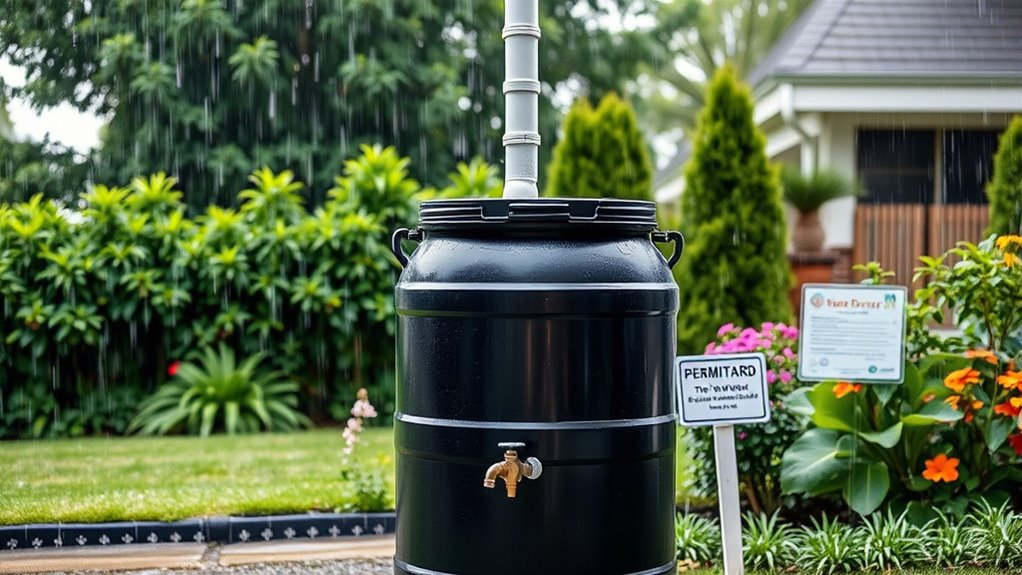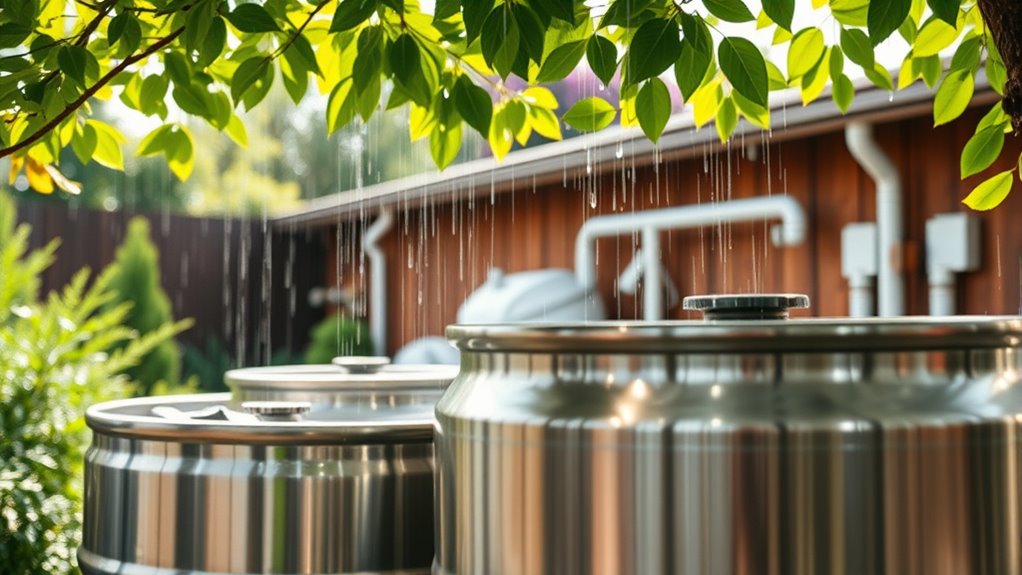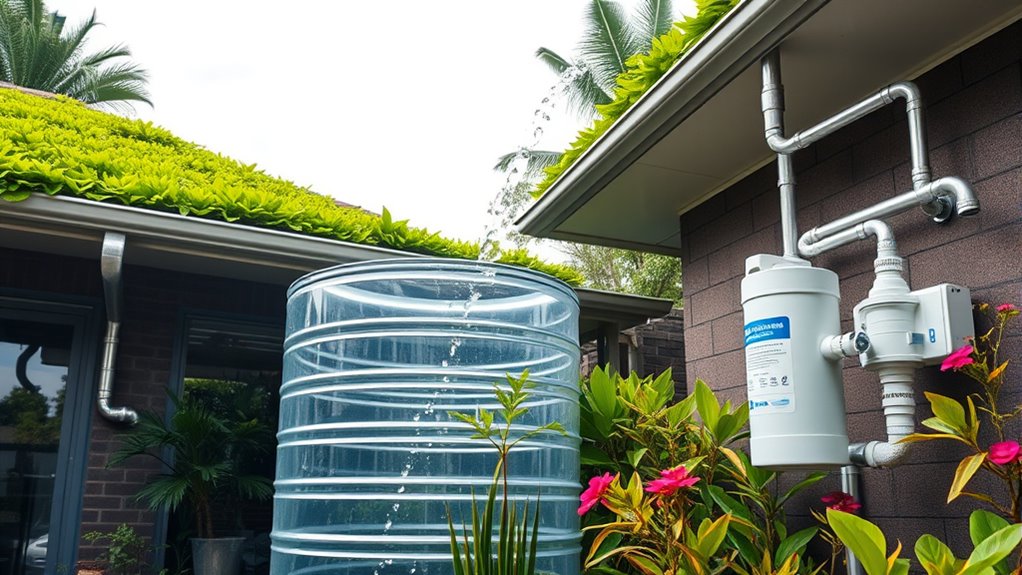To collect and use rainwater legally, you need to verify your local regulations, as rules vary by state and area. Usually, you can use rainwater for outdoor, non-potable purposes like irrigation and washing without permits, but indoor uses or large systems often require permits and special treatment. Proper design, labeling, and maintenance are essential to stay compliant. Keep in mind that understanding your local laws helps you avoid fines or legal issues—so explore further to ensure your system meets all requirements.
Key Takeaways
- Check local regulations and obtain necessary permits before installing rainwater harvesting systems.
- Use rainwater mainly for non-potable purposes like irrigation, landscaping, or vehicle washing.
- Design systems with proper filters, screens, and backflow preventers to prevent contamination and cross-connection.
- Ensure materials are corrosion-resistant and regularly maintain and clean the system for safety and efficiency.
- Consult local water authorities or programs for guidance, permits, and potential incentives or rebates.
Understanding State and Local Regulations for Rainwater Collection

Understanding the regulations governing rainwater collection is essential before installing a system. Each state has its own rules, and local jurisdictions may impose additional requirements. For example, Western states like California and Colorado have strict regulations to protect downstream water rights, often requiring permits for larger or indoor systems. Other states, such as Arizona and Utah, allow rooftop collection without permits, but larger systems might need registration. Some areas restrict rainwater harvesting to outdoor, non-potable uses like irrigation or vehicle washing, while indoor uses may require permits and advanced treatment. It’s *vital* to research your specific state and local laws before designing or installing your system. Failure to comply can lead to fines, system removal, or legal complications. Always check with local water authorities for current regulations. Additionally, understanding the permitting requirements can help ensure your rainwater harvesting system remains compliant and functional. Being aware of your local water rights helps prevent legal issues and supports sustainable water use practices.
Permitted Uses and Restrictions on Rainwater Harvesting

Rainwater harvesting offers a range of permitted uses, primarily focusing on non-potable applications like irrigation, landscaping, vehicle washing, and cooling systems. These uses are generally allowed without permits, especially for rooftop collection systems. These restrictions often aim to protect water rights, prevent contamination, and avoid connection to public water systems. Many jurisdictions limit the volume you can collect or specify that only rooftop surfaces can be used. Connecting rainwater systems to municipal water lines is usually prohibited. Indoor uses such as toilet flushing or drinking water typically require strict treatment, permits, and health department approval. Potable use is usually restricted unless advanced filtration systems are installed and approved. Additionally, water rights and regulations can vary significantly between regions, so understanding local laws is essential for compliant rainwater harvesting. It’s also important to be aware of regulatory compliance to avoid potential legal issues. Proper storage methods can help ensure rainwater remains uncontaminated and safe for intended uses.
Designing and Maintaining a Safe Rainwater System

To guarantee your rainwater system operates safely and effectively, proper design and ongoing maintenance are essential. First, ensure your system prevents contamination by using screens, filters, and backflow preventers. Second, choose materials that resist corrosion and bacteria growth, like food-grade plastics or stainless steel. Third, regularly inspect components for damage, leaks, or debris buildup, and clean filters and gutters accordingly. Fourth, clearly label all parts to avoid cross-connections with potable water sources. Additionally, keep detailed maintenance records and follow local building codes. To further enhance system safety, consider implementing routine water quality testing and monitoring. By focusing on these steps, you reduce health risks, extend system lifespan, and ensure compliance with regulations, making your rainwater harvesting safe and sustainable for years to come. Regularly checking the headphones connection quality can also help ensure your audio equipment functions properly during system monitoring or maintenance activities.
Navigating Permitting Processes and Compliance Requirements

Guiding the permitting process for rainwater harvesting systems can seem complex, but knowing the steps and requirements makes it manageable. First, research your state’s regulations, as rules vary widely. Check if permits are needed for system size, type, or intended use; some states limit rooftop collection to outdoor, non-potable uses without permits. You’ll likely need to submit plans detailing system design, including filtration and safety features, ensuring compliance with plumbing codes. Local authorities may require labeling, maintenance plans, or water quality testing, especially for indoor or potable applications. Be prepared to document system capacity, intended use, and safety measures. Staying informed about updates and consulting local officials or water agencies will help you navigate the process smoothly and avoid legal issues. Understanding permitting and safety requirements is essential for selecting reliable and compliant rainwater harvesting systems. Additionally, being aware of security considerations can help protect your system from tampering or theft. It’s also advisable to review any environmental regulations that may impact your setup or usage. Considering state-specific laws related to water rights and usage can further ensure compliance and sustainability. Being proactive in permitting processes can save time and prevent potential legal complications down the line.
Community Programs and Incentives Supporting Rainwater Systems

Many communities across the United States actively promote rainwater harvesting by offering various programs and incentives designed to encourage adoption. These initiatives help you overcome barriers and make sustainable systems more accessible. Here are four key ways communities support your efforts:
- Tax Rebates and Grants – Financial incentives reduce upfront costs, making rainwater systems more affordable.
- Educational Workshops – Programs teach you proper installation, maintenance, and legal considerations, ensuring safe and effective use.
- Technical Assistance – Local agencies provide guidance on system design and compliance, streamlining the permitting process. Understanding regulations can help you avoid legal issues and ensure your system meets local standards.
- Community Engagement – Initiatives foster shared resources and collective conservation goals, encouraging widespread participation. Recognizing community programs can further motivate your involvement in water conservation efforts. Additionally, many communities are now integrating sustainable practices into their water management strategies to promote long-term environmental health and compliance with financial regulations like those governing Miscellaneous Business Services.
These programs empower you to implement rainwater harvesting confidently while contributing to local water conservation efforts. Additionally, understanding Free Floating systems can help you choose the most adaptable and sustainable options for your property.
Frequently Asked Questions
Can I Legally Connect Rainwater Harvesting Systems to My Household Plumbing?
You generally can’t connect your rainwater harvesting system directly to your household plumbing. Most jurisdictions prohibit direct indoor connections to prevent contamination and health risks. Instead, rainwater is typically used for outdoor non-potable purposes like irrigation or car washing. If you’re considering indoor use, you’ll need strict treatment systems, permits, and compliance with local plumbing codes. Always check your local regulations before attempting any indoor connection.
Are There Specific Materials Approved for Constructing Rainwater Collection Tanks?
Building your rainwater tank is like crafting a sturdy vessel for nature’s gift. You should use materials approved by local codes, such as food-grade plastics, stainless steel, or concrete, to guarantee safety and durability. Avoid certain paints or metals that could contaminate water. Always check with your local authorities for specific material restrictions, and prioritize non-toxic, corrosion-resistant options to keep your harvested rainwater clean and safe for use.
What Are the Penalties for Installing a Rainwater System Without Proper Permits?
If you install a rainwater system without proper permits, you risk fines, penalties, or legal action from local authorities. They might require you to remove or modify the system, and in some cases, you could face court citations or damage claims. Not obtaining permits can also invalidate insurance coverage and prevent you from accessing potential incentives or tax rebates, so always check your local regulations before installation.
How Do I Verify if My Local Water Authority Approves My Rainwater Use?
You should contact your local water authority directly to verify if they approve your rainwater use. Check their website for guidelines or regulations, and call or email their office to confirm any permits or restrictions. It’s also helpful to review local ordinances or community programs that promote legal rainwater harvesting. Doing this guarantees you stay compliant with regulations and avoid potential fines or legal issues.
Are There Standard Safety Practices for Preventing Mosquito Breeding in Rainwater Tanks?
Ever wonder how to keep your rainwater tanks mosquito-free? You should cover your tanks securely with screens or tight-fitting lids to prevent mosquito entry. Regularly clean and inspect the tanks for standing water or debris, which can serve as breeding sites. Install mosquito dunks or larvicides if necessary, and make sure any overflow or vent openings are sealed. These practices help you maintain safe, mosquito-free rainwater storage.
Conclusion
Understanding the rules around rainwater harvesting is like charting a clear path through a dense forest—you’ll avoid pitfalls and make the most of your efforts. By knowing regulations, designing safe systems, and staying compliant, you can enjoy the benefits of rainwater collection without worry. Plus, community programs are like helpful guides along the way. With this knowledge, you’ll harness rainwater wisely and legally, turning your efforts into a sustainable, rewarding practice.





